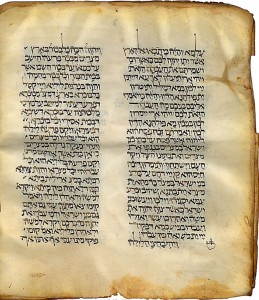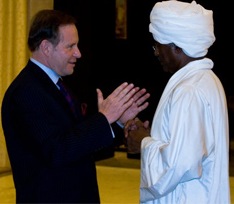 When an Arabic-speaking Muslim friend saw Mel Gibson’s movie Passion of the Christ with most of the dialogue in Aramaic, he was very surprised that he did not need most of the subtitles in English to understand the movie!
When an Arabic-speaking Muslim friend saw Mel Gibson’s movie Passion of the Christ with most of the dialogue in Aramaic, he was very surprised that he did not need most of the subtitles in English to understand the movie!
This connection is a critical bridge builder: sister languages, the Arabic, and the Aramaic, the written language which was once the global language, stretching from the Near East to Malabar in India and East China.
It is intriguing to note that Dr. Sidney Griffith, a Catholic priest and noted Syriac scholar, states that:
“Neither Qur’anic nor Aramaic Scholars have seen fit to make the linguistic connection, and it is about time that connection was made.”
Western academia has been primarily concentrated on Biblical Greek. What we need now is to consider the Aramaic/Syriac New Testament, written in the language Jesus actually spoke, as an additional tool for comparative analysis.
I have found this an invaluable tool working with the Islamic world in seeking bridges to the common ground. Muslims respect the similarity of words, meanings, and relate to the Eastern traditions and idiomatic nuances of the Aramaic.
They are very similar to the Arabic of the Qur’an and the Hebrew of the Torah; and can help unlock useful mysteries within the Eastern Holy Books.
The Prophet Muhammad and Aramaic
Some Islamic historians tell us that trusted Assyrian and Syriac speaking believers in Jesus interacted with the Prophet Muhammad and likely read to him from the Aramaic Eastern Text. The very word Qur’an, which means “The Recital,” is derived from an Aramaic/Syriac word qiriana.
Original Revelation of the Holy Books (Why the Aramaic has special meaning for Muslims)
The most compelling logic for use of the Aramaic New Testament in building bridges to the Common Ground deals with the Muslim view of “original revelation.”
Islam holds that God, through the angel Gabriel, spoke the revelation to the Prophet Mohammed in Arabic and is considered the official language of “The Recital.”
Thus, the only accepted written version is Arabic. Since Jesus spoke Aramaic, Muslims believe (consistent with Islamic logic) the “Holy” written version of the Gospel would be in Aramaic.
It is helpful to note that Aramaic was the first written Semitic script of the three, followed by Hebrew and finally, Arabic.
The ever widening “gulf” separating us is unfortunate, but it is my hope that studying the related Semitic languages of the East will serve as a key foundation, providing evidence that our faiths have more in common than we have believed in the past.
**************************************
 Mark Siljander is an ex-Congressman and the author of A Deadly Misunderstanding: A Congressman’s Quest To Bridge the Muslim-Christian Divide.
Mark Siljander is an ex-Congressman and the author of A Deadly Misunderstanding: A Congressman’s Quest To Bridge the Muslim-Christian Divide.
He represented Michigan for fifteen years, which includes three terms as a Member of the United States Congress, where he served on the International Relations Middle East Subcommittee and was Ranking Member of the Africa Subcommittee. He was the primary sponsor of the African Famine Relief Act.
Mark was later appointed by President Reagan as a US Ambassador (Alt. Delegate) to the United Nations in New York, where he served as a member of the Middle East and Africa Strategy Group of permanent representatives.
Ambassador Siljander is a student of several languages, including Chinese, Spanish, Arabic, Aramaic, and Hebrew, and has spent over ten years studying the three Holy Books of the Abrahamic faiths.
With over 26 years serving in the power circles of Washington and semi-official travel to nearly 130 countries, he has generated unique opportunities for frequent access to world leaders.
These experiences have led him to develop a unique paradigm for the peaceful resolution of conflict that has been successfully applied in several challenging areas of the globe.
Mark Siljander reinforces his conflict resolution efforts through regular travel overseas with Congressional and high-level delegations.






This manuscript picture that you have accompanying this story looks like a modern Hebrew or Aramaic text. I’m not a scholar but have taken some basic Hebrew in college and think this is not Aramaic.
Steve, that’s an Aramaic text. Just like you’ll find Turkish in Persian characters and even roman characters. Don’t be a doubter, you’ll end up as an atheist.
I think that if you’re going to learn Aramaic, you should learn arabic, since from arabic you can easily move on to Aramaic.
Oh and steve, you’re thinking of Syriac characters: http://en.wikipedia.org/wiki/Aramaic_alphabet
“Since the beginning of the nineteenth century there has been a constant recourse to Arabic for the explanation of rare words and forms in Hebrew; for Arabic though more than a thousand years junior as a literary language, is the senior philosophically by countless centuries. Perplexing phenomenon in Hebrew can often be explained as solitary and archaic survivals of the form which are frequent and common in the cognate Arabic. Words and idioms whose precise sense had been lost in Jewish tradition, receive a ready and convincing explanation from the same source. Indeed no serious student of the Old Testament can afford to dispense with a first-hand knowledge in Arabic. The pages of any critical commentary on the Old Testament will illustrate the debt of the Biblical exegesis owes to Arabic.” – Alfred Guillaume, The Legacy Of Islam, (Oxford, 1931), p. ix
I suppose Aramaic could hold the same.